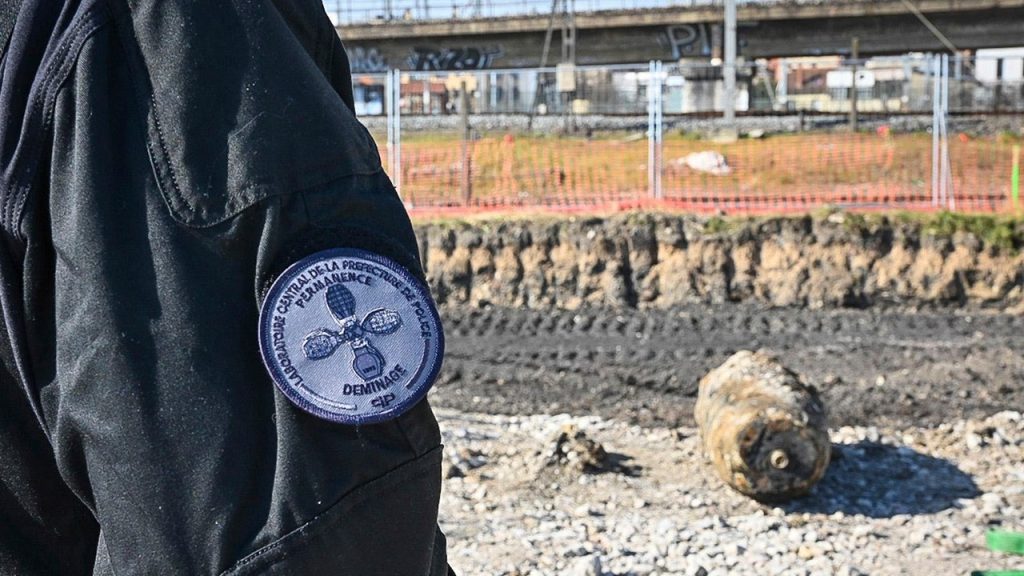An unexploded World War II-era bomb discovered near train tracks in the Seine-Saint-Denis area, just outside of Paris, has caused significant disruption to travel in the region. This half-ton bomb was unearthed during earthmoving work and led to immediate evacuation efforts and a large security operation. The bomb’s discovery resulted in the cancellation of Eurostar train services, affecting thousands of travelers at the Gare du Nord, Europe’s busiest railway station.
| Article Subheadings |
|---|
| 1) Discovery of the Unexploded Bomb |
| 2) Emergency Response and Evacuations |
| 3) Impact on Travel and Transportation |
| 4) Statements from Officials |
| 5) Summary of Continued Operations |
Discovery of the Unexploded Bomb
On March 7, 2025, construction workers engaged in earthmoving activities stumbled upon a half-ton unexploded bomb dating back to World War II. The incident occurred in the Seine-Saint-Denis area, a densely populated region located to the north of Paris. The historical context of such bombs in Europe, especially in France, is tied to the intense military activities that unfolded during the war. These remnants have continued to pose safety risks long after the conflict ended. French Transport Minister Philippe Tabarot confirmed the discovery, stressing that immediate action was necessary to ensure public safety.
Emergency Response and Evacuations
Following the bomb’s discovery, emergency protocols were swiftly activated. Bomb disposal experts were dispatched to the site to assess and manage the situation. Given the potential dangers associated with unexploded ordnance, a security perimeter was established, which restricted access to the area surrounding the bomb. Local residents were evacuated as a precautionary measure, ensuring their safety while authorities carried out the necessary procedures for safely neutralizing the bomb. The evacuation reflected a meticulous approach to public safety, as confirmed by Minister Tabarot who later expressed relief that no injuries were reported during this tense situation.
Impact on Travel and Transportation
The bomb’s presence led to widespread travel disruptions as authorities responded to the situation. Eurostar, a major rail service connecting Paris to London, announced the cancellation of all services to and from its hub at Gare du Nord due to the emergency situation. This station is integral for many travelers, as it accommodates around 700,000 individuals daily, making it particularly significant in Europe’s transportation landscape. The French national railway operator, SNCF, also confirmed the halting of services, advising passengers not to travel until after authorities provided clearance.
The ramifications of the disruption extended beyond trains. Roads leading into Paris, including the busy A1 highway and several arterial routes within the city’s ring road, were also closed, compounding transportation issues. The result was chaos for commuters, with pictures depicting large gatherings of frustrated travelers at Gare du Nord and St. Pancras International in London. As travel plans unraveled for thousands, the full extent of the impact of discovering the bomb became apparent, affecting an estimated 600,000 commuters.
Statements from Officials
In the wake of the events, both provincial and national leaders responded publicly. French Transport Minister Philippe Tabarot acknowledged the challenges posed by the situation, emphasizing the importance of prioritizing safety. He stated, “We’re delighted and relieved that all this has come to an end,” reflecting the collective relief among officials and the public alike when the situation was brought under control. Such statements aim to reassure the public about government vigilance in ensuring safety amid challenges. The authorities made it clear that movement would only resume once safety assessments were completed, illustrating the cautious strategy adopted in handling the incident.
Summary of Continued Operations
As the bomb disposal unit worked to render the bomb safe, ongoing assessments were made regarding when operations could return to normal. Although preliminary evaluations indicated that some trains might resume travel in the afternoon following the successful handling of the bomb, many services remained suspended for an extended period. SNCF and Eurostar communicated regularly with passengers through updates, highlighting their commitment to transparency amid the disruption. Finally, once the bomb was successfully disarmed, trains began operating again, albeit under a managed and cautious approach to restore normalcy to travel at the nation’s busiest rail hub.
| No. | Key Points |
|---|---|
| 1 | A WWII bomb was found near Paris train tracks. |
| 2 | Evacuations and a large security perimeter were established. |
| 3 | Travel disruptions affected Eurostar and SNCF services. |
| 4 | Statements from officials expressed relief after resolving the situation. |
| 5 | Train services resumed under controlled conditions after the bomb was disarmed. |
Summary
The discovery of an unexploded World War II-era bomb near Paris has underlined the lingering dangers of such historical remnants. This incident not only caused considerable disruptions to one of Europe’s busiest travel hubs but also tested the preparedness and responsiveness of local authorities. The swift actions taken for public safety highlight the ongoing challenges posed by unresolved wartime issues. As the situation returned to normal, it offered a reminder of the importance of vigilance and efficiency in emergency response protocols.
Frequently Asked Questions
Question: What does it mean when a bomb is described as unexploded?
An unexploded bomb refers to a munition that did not detonate upon impact and remains a potential threat until properly disposed of.
Question: How often are unexploded WWII bombs found in Europe?
It is not uncommon for unexploded WWII ordnance to be discovered in Europe, particularly in Germany and France, where extensive battles took place during the war.
Question: What procedures are followed when a bomb is discovered?
When a bomb is discovered, authorities typically evacuate the area, establish a safety perimeter, and dispatch bomb disposal experts to evaluate the situation and neutralize the bomb safely.


